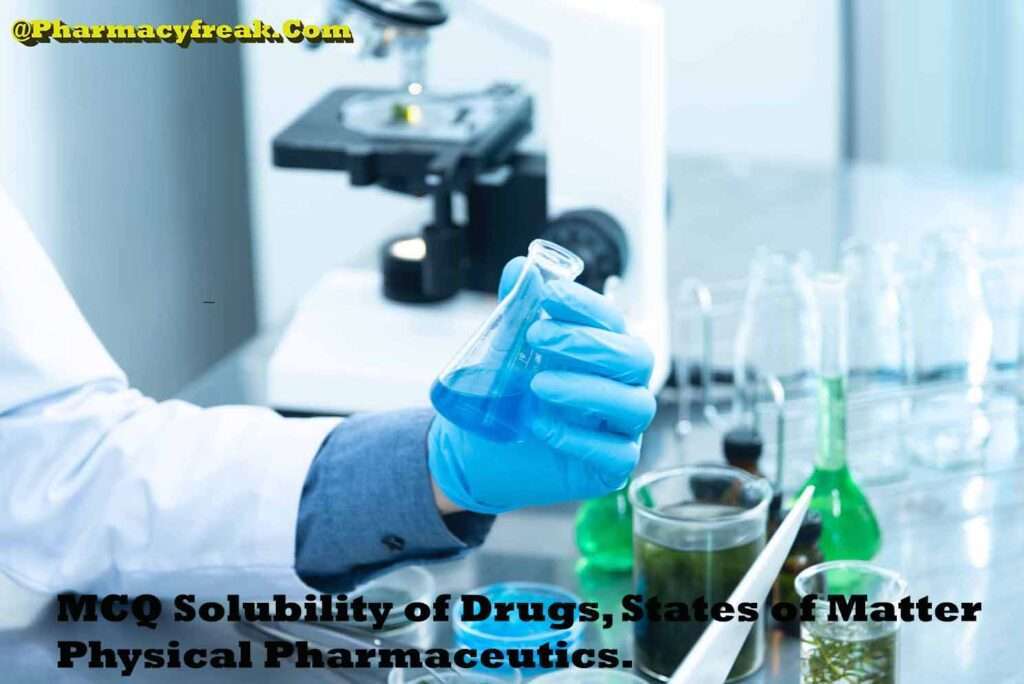
Multiple Choice Questions Of Solubility of Drugs, physical pharmaceutics, B.pharmacy, 3rd semester.
1. The general strategies for increasing the aqueous solubility of a relatively non-polar drug of weak ionization tendency includes…….
- (a) Increasing polarity of the solvent by the addition of cosolvents.
- (b) Increasing ionization of the drug by adjusting the pH of the solvent.
- (c) Choosing the amorphous form of the drug.
- (d) (b) and (c) only
Answer-(d) (b) and (c) only
2. When non-polar substances are dissolved in a polar solvent using surfactants, the process is called
- (a) HLB
- (b)-Solubilisation
- (c) Emulsification
- (d) Gelatinization
Answer-(b)-Solubilisation
4. Solubility of most gases usually …… with an increase in temperature.
- (a) decreases
- (b) increases
- (d) first increases and then decreases
- (c) does not change
Answer-(a) decreases
6. The ability of a substance to dissolve in a given solvent system depends on …….
- (a) nature and intensity of the forces present in the solute
- (c) interactions between solute and solvent
- (d) all the above
Answer-(a) nature and intensity of the forces present in the solute
8. The solubility of weak electrolytes and non-polar substances can be increased by adding water-miscible solvents. This process is known as ……
- (a) Co-solvency
- (b) Complexation
- (c) Both of these
- (d) None of these
Answer-(a) Co-solvency
9. How do co-solvents increase the solubility of poorly soluble drugs?
- (a) By reducing the interfacial tension between the predominant aqueous solution and hydrophobic solute.
- (c) Both of these
- (d) None of these
Answer-(a) By reducing the interfacial tension between the predominant aqueous solution and hydrophobic solute.
10. Which of the following co-solvents are used to increase the solubility of a drug?
- (a) Ethanol
- (c) Glycerin
- (b) Sorbitol
- (d) All the above
Answer-(d) All the above
Multiple Choice Questions of States of matter, physical pharmaceutics, B.pharmacy, 3rd semester.
2. The phenomenon in which a substance exists in more than one crystalline form is called
- (a) Polymorphism
- (b) Crystallinity
- (c) Anisotropy
- (d) Polycrystallinity
Answer-(a) Polymorphism
3. Amorphous form dissolves crystalline form.
- (a) slower than
- (b) faster than
- (c) at the same rate as
- (d) Does not dissolve
Answer-(b) faster than
4. Mesomorphic substances are ……
- (a) in between solid and liquid
- (b) Nematic
- (c) Smectic
- (d) have different properties in different directions.
Answer-(a) in between solid and liquid
5. What kind of liquid crystals consist of parallel molecules in layers?
- (a) Cholesteric
- (b) Nematic
- (c)-Smectic
- (d) All of the above
Answer-(c)-Smectic
6. The change of state from solid to directly into gas is known as ……
- (a) Fusion
- (b) Boiling
- (c) Sublimation
- (d) Evaporation
Answer-(c) Sublimation
7. The critical point of a pure substance is ……
- (a) the highest temperature and pressure for which liquid and vapor can coexist.
- (b) the point at which saturated liquid and saturated vapor curves meet.
- (c) the point where vapor pressure has its largest possible value.
- (d) all of the above
Answer-(d) all of the above
8. Which of the following properties are not shared by crystalline solids and amorphous solids?
- (a) Definite shape
- (b) Definite volume
- (c) Incompressibility
- (d) Definite melting point
Answer-(d) Definite melting point
9. Ratio of the velocity of light in a vacuum to the velocity of light in substance at same wavelength called as
- (a) Refractive index
- (b) Optical rotation
- (c) Dipole moment
- (d) None of these
Answer-(a) Refractive index
10. The ability of a substance to rotate the plane-polarized light is referred to as
- (a) Refractivity
- (b)-Optical activity
- (c) Dielectric constant
- (d) Dipole moment
Answer-(b)-Optical activity
11. Due to increase in temperature refractive index ……
- (a) increases
- (b) decreases
- (c) remains unchanged
- (d) depends on substance
Answer-(b) decreases
12. Oscillometry method is used to determine…….
- (a) Refractive index
- (b) Dielectric constant
- (c) Dissociation constant
- (d) Optical rotation
Answer-(b) Dielectric constant
13. When the analyzer is oriented into the polarizer, no light reaches the detector.
- (a) 90°
- (b) 45°
- (c) 180°
- (d) 0°
Answer-(a) 90°
14. Name a process through which a chemical compound breaks up into smaller constituents as a result of either energy or by the effect of solvent on a dissolved polar compound.
- (a) Dissociation
- (b) Association
- (c) Breaking
- (d) Desorption
Answer-(a) Dissociation
- Pharmacognosy and phytochemistry mcq with answer
- MCQ cycloalkanes 3rd Semester B.pharmacy
- MCQ Polynuclear Hydrocarbons Pharmaceutical Organic Chemistry 3rd semester B.Pharmacy
- MCQ/ Fats and Oils Pharmaceutical Organic Chemistry 3rd semester B.Pharmacy
- MCQ Phenol pharmaceutical organic chemistry 3rd semester B.Pharmacy
- MCQ Benzene Pharmaceutical Organic Chemistry 3rd semester B.Pharmacy

I am a Registered Pharmacist under the Pharmacy Act, 1948, and the founder of PharmacyFreak.com. I hold a Bachelor of Pharmacy degree from Rungta College of Pharmaceutical Science and Research. With a strong academic foundation and practical knowledge, I am committed to providing accurate, easy-to-understand content to support pharmacy students and professionals. My aim is to make complex pharmaceutical concepts accessible and useful for real-world application.
Mail- Sachin@pharmacyfreak.com